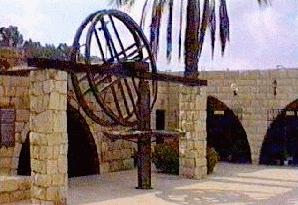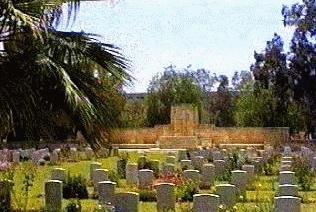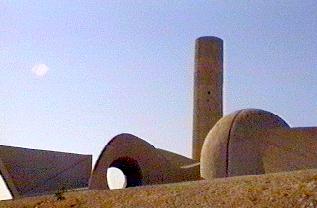 Ancient Beer-Sheva
Ancient Beer-ShevaThe history of Beer Sheva takes us back thousands of years. Its location on the main trading roads junction between East and West, and the availability of water had contributed a great deal to the importance and the development of Beer Sheva through the history. Abraham arrived here on the second millennium B.C.,. He digged water wells (the legend tells us - 7 wells), fought with the local tribes and than settled down in the region. This settlement was the first basement for the recognition in the rights of the Jewish people on the Israel land. Further in the history of the Jewish people, Beer Sheva continued to develop and became an important part of the security and control at the south region of the kingdoms of ancient Israel.
Tel-Beer Sheva. the ancient city which is located 5 Km south east of new Beer Sheva, is an evidence to the high abilities of construction and management of ancient cities.
Through the Roman/Byzantine era, until the 7th millennium, Beer Sheva was designed to protect the country from the desert violent tribes. The emperors and the governors reinforced the city and made everything to bring settlers. They had built churches and government buildings is the city and the periphery. Remains of one big Byzantine church was discovered accidentally, in 1995, near the main market of Beer Sheva. The city was not mentioned often in the Christian church history, but it is known that Christian pilgrims were passing through Beer Sheva on their way to Sinai desert churches.
 The Turkish Era
The Turkish EraThe Turkish Authomans replaced the Byzantine regime and Beer Sheva was forgotten for long time. In The end of the 19th century and the beginning of the 20th century, Jewish merchants from Gaza, were coming to Beer Sheva to sell products to the local population and started again the connection to Abraham legacy.
In 1900, the Turkish build the city in its today’s location in purpose to cement the loyalty of the Bedouins tribes to the authorities. They had build government institutes, school, train station and main trading street in the center. The Jews were also allowed to settle in Beer Sheva and the first family established a wheat grain grinding factory. The Jewish community was expending slowly. In the first world war, when the Turkish forces were trying to fight their way to the Suez canal, Jewish soldier were recruited and stationed in Beer Sheva area and the Negev desert. The small Jewish community in Beer Sheva helped them in any possible way.
 The British Era
The British EraWhen the British army conquered Beer Sheva on November 1917, The city of Beer Sheva expended and had 7000 inhabitants. The main street was for business and coffee shops, and the families lived in tin made houses, surrounded by intimate walls reflecting the intimacy required by the Arab tradition. Some of those houses can be seen today in the old part of the city.
In 1929, (British occupancy of Israel), at the beginning of the tension between the Jews and the Arabs over the land of Israel, many of the Jews left Beer Sheva. They returned occasionally, but before 1936-8 tragic events, they all left Beer Sheva and returned only after freeing Beer Sheva from the invading Egyptian army in October 1948.
In the 40s, Jewish settlements were built near Beer Sheva - Hazerim, Beit-Eshel and Nevatim. In 1948, after the declaration of independent of Israel, The Egyptian army moved in to Israel and conquered Beer Sheva. It was his main command post until the IDF released Beer Sheva on October 1948, in an operation called “Moses Operation”. During the war Beer Sheva was abounded totally and was resettled after the war.
 The battle to free Beer Sheva.
The battle to free Beer Sheva.
Beer Sheva was freed on 20-21 of October 1948. The United Nations and the pressure of the Arab world, put a lot of efforts and pressure on the young Israeli government to stop the fighting. David Ben-Gurion, The first Israeli prime minister, thought that Beer Sheva is very important for the future security of Israel and the army should continue of the release of the Negev desert from the occupying Egyptian army, rejected the UN ultimatum and ordered to continue the operation in the Negev. At 0400 of 21 of October 1948, the 82nd battalion moved from Mishmar Hanegev junction (20 Km north of Beer Sheva) and attacked Beer Sheva from North and West directions. Part of the force attacked from the Turkish train station and part from Hazerim direction. At 0945, the enemy forces surrounded and Beer Sheva was released. In the 70s, for the memory of the battle and the dead soldiers, a memorial monument was build north/east of Beer Sheva (3 Km from the center) on the highest hill observing the city. It was designed by the sculptor Danny Karavan.
 Reinhabiting Beer Shaba
Reinhabiting Beer Shaba
After the war, in 1949, new immigrants and exsoldiers were came to Beer Sheva and started the new era in Beer Sheva history. The city grow slowly but steady and today, in 1996, it has a population of 165000 citizens. It became the center of the Negev desert for all Israelis, Jewish and Arabs. It gives administrative, health, commercial and cultural services to over 300000 people.


